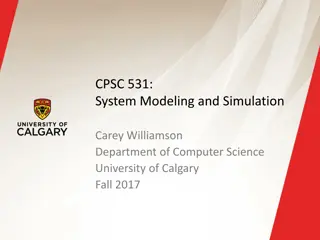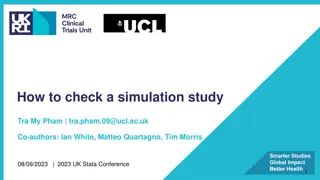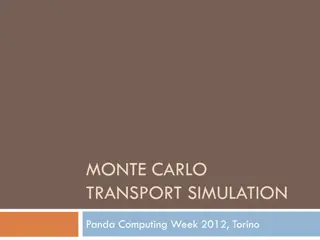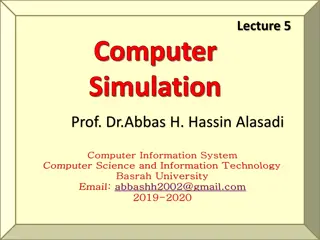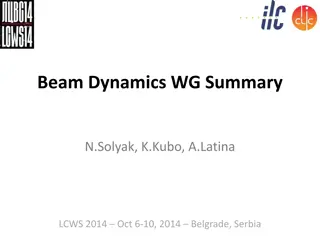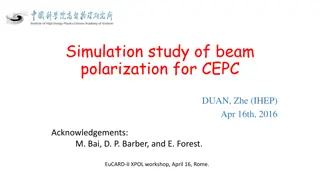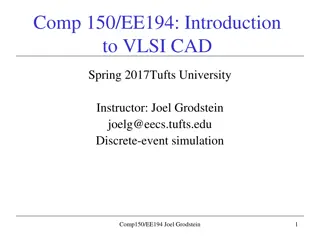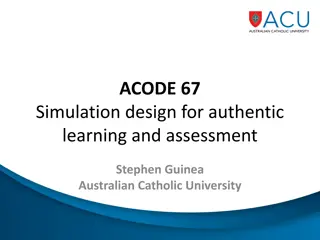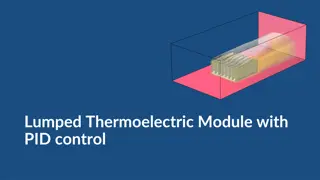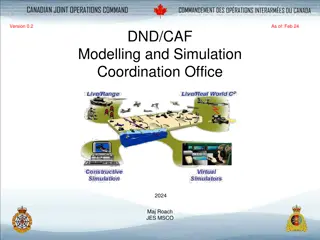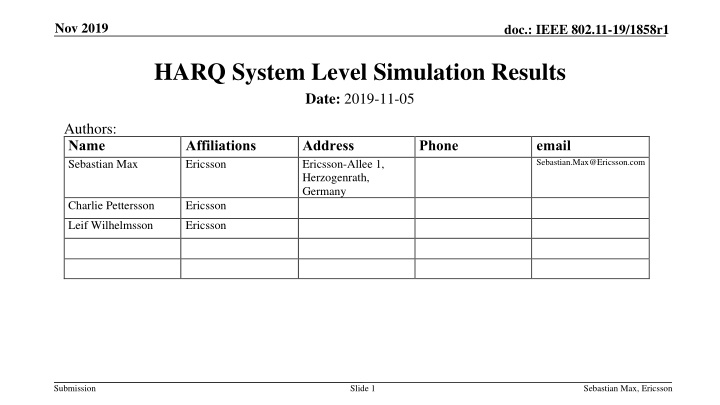
IEEE 802.11-19/1858r1 HARQ System Level Simulation Results
Explore the system level simulation results of Hybrid Automatic Repeat reQuest (HARQ) in the reference scenario Residential of TGax, showcasing increased throughput and performance enhancements without the need for rate adaptation. The submission delves into the comparison between Rate Adaptation and HARQ, highlighting their respective optimization approaches and benefits. Moreover, the influence of combined HARQ and rate adaptation is analyzed in different scenarios, emphasizing the compensatory role of HARQ in addressing varying channel conditions and mobility effects. Dive into the detailed findings and conclusions observed from the simulation results presented in Nov. 2019 documentation.
Uploaded on | 1 Views
Download Presentation

Please find below an Image/Link to download the presentation.
The content on the website is provided AS IS for your information and personal use only. It may not be sold, licensed, or shared on other websites without obtaining consent from the author. If you encounter any issues during the download, it is possible that the publisher has removed the file from their server.
You are allowed to download the files provided on this website for personal or commercial use, subject to the condition that they are used lawfully. All files are the property of their respective owners.
The content on the website is provided AS IS for your information and personal use only. It may not be sold, licensed, or shared on other websites without obtaining consent from the author.
E N D
Presentation Transcript
Nov 2019 doc.: IEEE 802.11-19/1858r1 HARQ System Level Simulation Results Date: 2019-11-05 Authors: Name Sebastian Max Affiliations Ericsson Address Ericsson-Allee 1, Herzogenrath, Germany Phone email Sebastian.Max@Ericsson.com Charlie Pettersson Ericsson Leif Wilhelmsson Ericsson Submission Slide 1 Sebastian Max, Ericsson
Nov 2019 doc.: IEEE 802.11-19/1858r1 Abstract HARQ is one of the features considered for EHT in order to enhance the performance. This contribution provides system level simulation results of HARQ in the reference scenario Residential of TGax. We show that HARQ increases the throughput in this dense scenario with highly unpredictable interference. Additionally, HARQ is extended by the multi-layer approach presented in [3]. In this configuration the throughput is further increased without the need of rate adaptation. Submission Slide 2 Sebastian Max, Ericsson
Nov 2019 doc.: IEEE 802.11-19/1858r1 Rate Adaptation vs. HARQ Rate adaptation tries to optimize the transmission parameters before the initial transmission Optimization problem: Select the transmission parameters such that The transmission time is minimized And the error probability is below a threshold Using (incomplete) knowledge of the channel and interference HARQ handles transmission errors after the initial transmission Every (re)transmission keeps on adding information until all bits are received correctly retransmission initial transmission retransmission rate adaptation MCS t HARQ Process Submission Slide 3 Sebastian Max, Ericsson
Nov 2019 doc.: IEEE 802.11-19/1858r1 Baseline Rate Adaptation: Minstrel [1] Typical open-loop rate adaptation For every transmission Every 100ms Calculate success rates Calculate expected throughput Build new regular tx chain: MCSs with 1. Best throughput 2. 2nd best throughput 3. Highest success rate 4. Most robust No Yes Probe? Select random MCS for transmission Regular tx chain 1 2 3 4 Probe tx chain P 2 3 4 Collect success / failure statistics Submission Slide 4 Sebastian Max, Ericsson
Nov 2019 doc.: IEEE 802.11-19/1858r1 We showed the effect of combined HARQ & rate adaptation in [2] Normal: Minstrel HARQ using soft combining Modelled by adding the effective SINRs of the (re-)transmissions HARQ process lifetime = one TXOP Rate adaptation (Minstrel) for next TXOP HARQ with aggressive lifetime HARQ process lifetime = (up to) 7 transmissions No rate adaptation for retransmissions Simple single-link scenario Channel variation due to mobility Conclusion: HARQ compensates the inability of the link adaptation to follow the varying channel Results with mobility ~ 1m/s 300 Normal HARQ HARQ w. aggressive RA 250 200 Throughput [MB/s] 150 100 50 0 0 5 10 15 20 25 30 Distance AP-STA [m] Submission Slide 5 Sebastian Max, Ericsson
Nov 2019 doc.: IEEE 802.11-19/1858r1 System Level Simulation Reference scenario "Residential" from the TGax simulation scenarios [3] Apartment building with 10m 10m 3m apartments 5 floors, 10 rows, 2 columns 1 AP, 2 STAs in each apartment Assume 3 channels, random selection 1/3 of all APs & associated STAs on the same channel Same traffic pattern for all apartments Submission Slide 6 Sebastian Max, Ericsson
Nov 2019 doc.: IEEE 802.11-19/1858r1 Results: Downlink Traffic Only Same traffic pattern for all apartments Only downlink Constant bit rate, 1000B packets, x per second From AP to both associated STAs HARQ has slightly higher capacity Although the rate adaptation algorithm is simpler / less adaptive: No adaptation for retransmissions Submission Slide 7 Sebastian Max, Ericsson
Nov 2019 doc.: IEEE 802.11-19/1858r1 Results: Uplink & Downlink Traffic Same traffic pattern for all apartments 50% uplink, 50% downlink Constant bit rate, 1000B packets, x per second From AP to both associated STAs and from both STAs to AP HARQ gain is significant STAs transmit & interfere with other BSSs Interference variance increases Throughput of Minstrel is slightly reduced HARQ has better opportunities for combining Submission Slide 8 Sebastian Max, Ericsson
Nov 2019 doc.: IEEE 802.11-19/1858r1 Can We Do Better? retransmission HARQ process initial transmission rate adaptation Idea: No rate adaptation, always use high MCS Good channel Everything is fine Bad channel HARQ process gets some information May require many retransmissions for success, high overhead Idea 2: No rate adaptation, always use high MCS, but opportunistically Good channel Same throughput as above Bad channel Extract as much useful information as possible, apply HARQ for the rest Submission Slide 9 Sebastian Max, Ericsson
Nov 2019 doc.: IEEE 802.11-19/1858r1 Multi-Layer Modulation [4] Sequential mapping of codewords to symbols Parallel mapping of codewords to symbols Data Data Preamble Preamble OFDM Symbols OFDM Symbols 10 00 10 00 11 01 11 01 Submission Slide 10 Sebastian Max, Ericsson
Nov 2019 doc.: IEEE 802.11-19/1858r1 Multi-Layer Modulation: Error Statistics SNR < 0dB All transmissions fail SNR > 25dB All transmissions succeed 0dB < SNR < 25dB Robust layer(s) can be decoded successfully Other layers end up in HARQ processes and are assigned a more robust layer in the retransmission Implemented strategy: Top-to-bottom Simple, but not necessary optimal Submission Slide 11 Sebastian Max, Ericsson
Nov 2019 doc.: IEEE 802.11-19/1858r1 Results: Downlink Traffic Only Same traffic pattern for all apartments Only downlink Constant bit rate, 1000B packets, x per second From AP to both associated STAs Replacement of rate adaptation by Multi- Layer Modulation increases the system capacity compared to Minstrel & compared to HARQ Combined MultiLayer + HARQ further increases system capacity Submission Slide 12 Sebastian Max, Ericsson
Nov 2019 doc.: IEEE 802.11-19/1858r1 Results: Uplink & Downlink Traffic Same traffic pattern for all apartments 50% uplink, 50% downlink 1000B packets, x per second From AP to both associated STAs and from both STAs to AP Here, HARQ with rate adaption results in similar throughput as HARQ+Multi- Layer Submission Slide 13 Sebastian Max, Ericsson
Nov 2019 doc.: IEEE 802.11-19/1858r1 Conclusion We evaluated HARQ and Multi-Layer Modulation with the help of system level simulations for TGax reference scenario "Residential" Pre-transmission rate adaptation has to estimate the instantaneous SNR Not optimal in scenarios of varying interference HARQ helps in these scenarios Assures that at least some information can be used Still the problem of inaccurate pre-transmission link adaptation remains Multi-Layer Modulation solves the problem of the rate adaptation Opportunistic usage of the channel Instantaneous SNR information not required Submission Slide 14 Sebastian Max, Ericsson
Nov 2019 doc.: IEEE 802.11-19/1858r1 References [1] F. Fietkau, D. Smithies, "Linux Wireless Minstrel High Throughput", [online] Available: https://wireless.wiki.kernel.org/en/developers/documentation/mac80211/ratecon trol/minstrel [2] S. Max et al., "Combined HARQ and Rate Adaptation", dcn 11-19-1196-01 [3] S. Merlin et al., "Simulation Scenarios", dcn 11-14-0980-16 [4] L. Wilhelmsson et al., "Some results on HARQ performance in dense deployments", dcn 11-19-1133-00 Submission Slide 15 Sebastian Max, Ericsson

